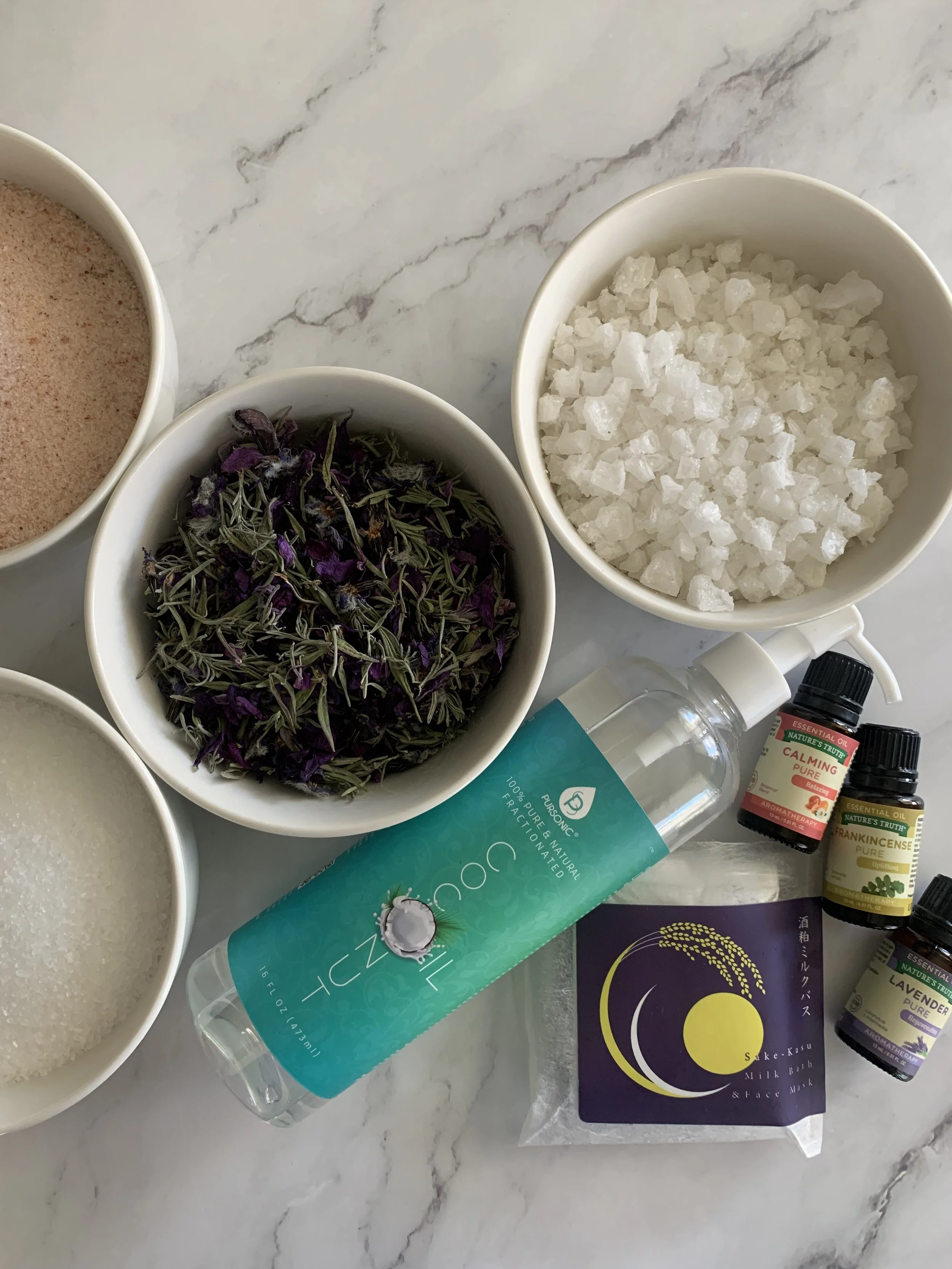Epsom salt
If you are one of my clients, you already know that I recommend weekly Epsom salt baths to help you detox, relax, recover, and sleep better! While simple Epsom salt baths are great, in this blog, I am sharing one of my favorite bath salt recipes, with added dried flowers from my garden.
If you want to read more about detoxing and environmental health, please check out my FREE ENVIRONMENTAL HEALTH guide here.
Many people don't know, but Epsom salts are not salts but magnesium sulfate, which means soaking in an Epsom salt bath is a mild form of magnesium therapy. Magnesium is an essential mineral that plays a role in over 300 enzymatic reactions in the body, reactions involved in bodily processes that range from regulating blood pressure and supporting metabolism to keeping blood sugar levels stable and even synthesizing DNA.
Supplementing with magnesium is beneficial for brain health, muscle health, hormonal health, constipation, anxiety, headaches, body aches, and insomnia. I always take an Epsom salt bath after an intense weight-lifting workout or a stressful day.
So while there are many reasons to establish a regular bath ritual, the idea that we can reap the benefits of a magnesium supplement by absorbing Epsom salts through our skin takes this wellness staple to a whole new level. Please understand that you might have to supplement with oral magnesium if you are deficient, which most people are.
If you want to read more about magnesium supplementation and the best forms of magnesium, you can download my FREE DRUG-INDUCED NUTRIENT DEFICIENCIES guide here!
Sea salts are harvested from seawater and are mostly composed of sodium chloride. Since they’re not refined or only minimally processed, sea salts retain numerous valuable minerals, including magnesium, potassium, calcium, phosphorus, bromine, boron, zinc, iron, manganese, copper, and silicon. Like Epsom salts, sea salt baths ease tension and stiffness while stimulating circulation and detoxification.
Pink Himalayan salt is a rock salt found high in the Himalayan mountains. Though it’s about 98% sodium chloride, pink Himalayan salt also contains up to 84 other trace minerals and elements! The pink color is pretty and ideal for adding a pop of color and interest to your DIY bath salt recipe. Also, pink Himalayan salt is my favorite salt to cook with.
Sake-kasu is the residue from sake making, known as sake-kasu (sake-lees). The nutrients left over from the yeast in the sake-kasu make it an incredible health food as well as a potent natural skincare ingredient. Sake-kasu contains kojic acid, a by-product of sake fermentation. Sake-kasu also contains vitamin D, vitamin B1, and other nutrients that inhibit the performance of melanin, the main culprit of sun spots, age spots, and freckles. Sake-kasu baths have incredible moisturizing and heat-retention effects.
Fractionated coconut oil has hydrating properties that help to soothe and soften your skin while also combating stretch marks.
Essential oils really enhance the healing properties of your natural bath salts and your overall bath experience! Certain scents are very effective at calming nerves or elevating your mood. Beyond the benefits of aromatherapy, various herbs, and essential oils offer unique healing properties. For example, lavender has antioxidant, antibacterial, anti-inflammatory, and anti-fungal properties, and is known to ease anxiety and calm the mind. Frankincense essential oil is known for helping relieve chronic stress and anxiety, reducing pain and inflammation, and boosting immunity. Citrus oil blends uplift mood, ease anxiety, reduce frustration, helping you relax and energize.
The dried flowers added to this mix are lavender, Borage flowers, and hoary stock, as these were the flowers growing in my garden at this time. You can use any prefered or medicinal flowers that speak to you like rose petals.
Recipe
Ingredients
5 cups unscented Epsom salt
2 cups pink Himalayan salt
2 cups sea salt crystals
20g of dried flowers of choice
30g sake-kasu powder
4 Tbsp fractionated coconut oil
30 drops of each essential oil (I used lavender, frankincense, and citrus)
Instructions
Weigh all your dry ingredients and add them into a mixing glass bowl;
Add the liquid ingredients and mix everything with your hands until homogenous;
Transfer the bath salt to a big glass container or several containers, and use it as needed;
Add a handful of salt to every bath you take.
Enjoy!
As usual, these are my thoughts and ideas, not medical advice. You are encouraged to create your own recipes or search for some suited to your needs. I am just sharing my recipes, hoping that I can inspire some of you to make healthier choices.
Please remember that we all have different nutritional needs and that food affects us differently. If you are not sure which foods are best for you, reach out for a free phone consultation.
In good health,
Ioana











